|
Infrastruktura - Środowisko - Energia
Dodatek lobbingowy do "RZECZPOSPOLITEJ".
9 września 2008 r.
po polsku
Reclamation and development of brown coal post-mining areas
Miners in Polish brown coal mines have conducted - systematically and according to the requirements of the art of mining - the processes of reclamation and development of "recovered" areas as the exploitation fronts move on. Mines do not fall behind with the reclamation of post-exploitation areas. Works are conducted at a high European level which makes it possible to use the areas for agricultural or forest production, as well as for other activity, including recreation.
In the branch of brown coal, the "Konin" mine and the "Turów" mine were the first to make an attempt at reclaiming post-mining areas, whereby they put into practice the principle, formulated by professor Walery Goetl, the chancellor (rektor) of the AGH University of Science and Technology in Kraków, who introduced the term "sozology": "What the man has destroyed, the man has to repair". Scientific-research works began already at the turn of the 1950s and 1960s. Detailed criteria concerning the organization of an experimental base in terms of agricultural reclamation were drawn up by the Department of Land Science of the AGH University in Kraków in 1960.
Table 1 presents the data concerning the area management for individual mines.
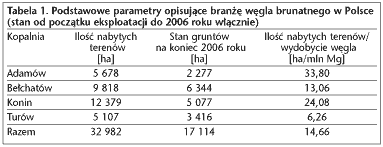
The "Adamów" mine
The KWB "Adamów" brown coal mine has carried out mining activities in the region of Turek for over 40 years. For its own needs the mine has gradually taken tens of hectares of land which could be used for different purposes. In the 1960s, reclamation went mainly in the direction of forest production. In 1978, when a new method of dumping was introduced, consisting in dumping the dump top below the level occupied by the dumping equipment, land development changed its direction from the forest into the agricultural one. Works also began regarding the methods of end drifts development. One of such activities was the decision to use the end drift of the Bogdałów opencast mine as a dump for the Koźmin opencast mine, which was being constructed a few kilometres away. In 1994, in the place used as a dump for the Bogdałów opencast mine, with the agreement of the Forest District Office of Turek, to which the area was to be returned, the mine created a water body, 10.84 ha in area and 600,000 m3 in volume. The body is supplied with part of the water coming from surface drainage of the "Adamów" opencast mine. Experience gained during the construction of the Bogdałów water body, together with social expectations, led the mine to the decision about water direction of dump reclamation. The best example of this trend is the Przykona water body, 7.3 million m3 in volume and 169 ha in area, including water surface of 140 ha. The mine conducted all the work related to the construction of the body as well as of the ditches for water supplying and carrying within its own property, while the total reclamation area was 242 ha. Nowadays, this area is one of the most attractive ones in the region of Turek and in the whole county (powiat) of Turek. Once the complex became the property of the administrative district of Przykona it became one of the assets of the tourist-recreational activity, as apart from the distant Jeziorsko water body this region lacks natural water bodies. The mine intends to continue the reclamation process in the water direction. Recently, another water body has been opened for public use in the area of the external dump of the Koźmin opencast mine (fig. 1).
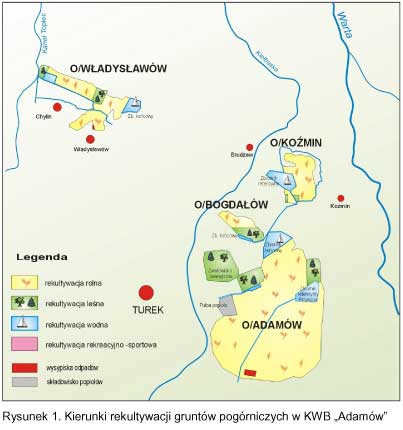
Like the previous ones, it is going to be used for numerous purposes but above all it is going to be an element perfectly harmonizing with the surrounding landscape, the origin of fauna and flora revival in the post-mining areas, and last but not least, it is going to be a complex contributing to the increasing attractiveness of yet another administrative district of this region as well as to the economic growth of this area. Recently, the mine has approached water management in an extensive way. In co-operation with Regional Water Management Board in Poznań and Voivodeship Board for Land Improvement and Water Equipment in Poznań the mine has drawn up the Plan for hydrological network and water management in the region of the KWB "Adamów" and "Koźmin" opencast mines. The plan is aimed at: streamlining water management, minimizing the negative influence of the deposit drainage by collecting water in gradually constructed reservoirs, supplying the necessary amount of water for the purposes of agricultural irrigation, and creating flood reserve. Eventually, 7 water bodies are to be constructed in the region, interconnected by a hydrological network and hydro-technical buildings; they are to be 200 million m3 in volume, involving water transfer from the Jeziorsko water body. Some of these bodies will be constructed for recreational purposes, while others for environmental purposes, i.e. for bird sanctuaries. Such a method of developing post-mining areas is an attractive and expected trend, which combines both social needs and the requirements of environmental protection.
The Bełchatów mine
There are two fields in the mine: Bełchatów and Szczerców which require the reclamation of the post-mining areas. The Bełchatów field, which is currently being exploited, covers the area of 3,887 ha and will be depleted by about 2020. In order to make the deposit available it was necessary to remove the overburden, which had been situated on the external dump elevated 195 m above the ground level; the base of the dump covers the area of 1,480 ha. The dumping has been reclaimed in the forest direction, by planting properly selected species of trees and bushes (14,000 items per ha). Nowadays, the overburden is dumped in the depleted drift of the Bełchatów opencast mine, the part of which will also be forested; another part will be used as a dumping site for ashes and accompanying minerals, whereas yet another part will be converted into a water body. In 2002 the works began so as to make the Szczerców field available; with its target area of approximately 2,360 ha, it will allow both the mine and the power plant to function till 2038.
In order to make coal available in the Szczerców field it is necessary to remove the overburden and place it on an external dump of a target area of 8 km2 . According to one of the considered versions of end drift development the dump will be treated as a temporary one. The overburden placed in it may be used to make the drift of the Szczerców opencast mine shallower, once the coal deposit is depleted around 2038. The exploitation of brown coal deposit will lead to the appearance of two end drifts, on account of the occurrence of Dębina salt diapir. As a result, two water bodies will be created, 32.5 km2 in area and 2.4 milliard m3 in volume, connected by a canal (fig. 2 ).
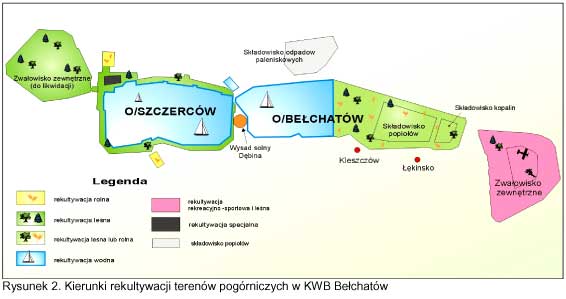
Drift reclamation and development will require a lot of financial and technical effort; one of the reasons for it is the exploitation of drifts, which is taking place at the same time. It is predicted that drift development will generally evolve in the water direction. Immediately after their exploitation is finished, drifts will be approximately 280 m deep. It is predicted that the process of preparing post-exploitation drifts to be filled with water will have finished around 2049 once all the filling works are completed so that the bottoms of future lakes will be situated above the level of the salt diapir top.
It is expected that in the case of relying exclusively on the forces of nature, the process of filling the water bodies with water may last about 60 years, whereas in the case of extra supplies with waters others than those of the depression cone - 18 years. One of the tasks already completed by the mine, which has made the region more attractive, is a ski run, over 850 m long, for the lovers of winter sports, which is located on the slope of an external dump (Góra Kamieńsk), together with modern infrastructure including ski lifts and a catering-accommodation base. Recently, an over-500-metre sledge slide has been opened for public use. At present, the mine is considering an extensive development of post-mining areas, which would include creating indoor ski runs, hippodromes and autodromes, racetracks or even a track imitating that of Formula 1, artificial water courses with beaches as well as sailing and motorboating harbours, and finally, a technological park which could house the museum of mining machines (excavators and dumping machines) and equipment. Once the above-mentioned complex is completed the mining region would become Poland's largest centre of sports and recreation.
The Turów mine
The Turów mine began the reclamation of post-exploitation areas in the 1960s, adopting the idea of forest development of the external dump. Some attempts had been made at reclaiming the post-mining areas in agricultural direction; no grounds had been found for them, however, as the costs had been increasing while the yield had been far from satisfactory. Such activities were supported by administrative decisions which determined the forest direction of development. In 2008 the Turów mine completed the works related to the reclamation of the external dump. As a result, a dense forest complex was created, covering the area of over 2,175 ha. The results of conducted reclamation works contribute above all to the higher quality of basic environmental components, such as: atmospheric air, water and soil. The anthropogenic forest complex which is developing on the external dump significantly contributes to increase the forestation rate of the industrialized region. Although the age structure of afforested areas is typical for young forests it has already become an important landscape and climate element of the administrative district of Bogatynia.
In the last few years the Turów mine has twice received the award of the Polish Chamber of Ecology, in recognition of its achievements in the field of reclamation works.
It is assumed that brown coal opencast exploitation in the Turów mine will be carried out until 2040. The internal dump of the mine (approximately 1,200 ha), similarly to the external one, will be reclaimed in the forest direction. The remaining part of the drift will be converted into a water body, approximately 1,800 ha in area, intended for recreational purposes (fig. 3). It is expected that all reclamation works should be completed by 2060.
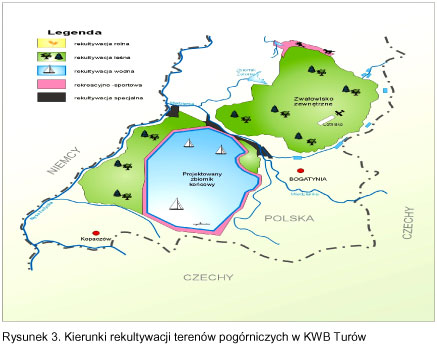
The "Konin" mine
The multi-pit "Konin" mine have successfully implemented new dumping methods upon opening successive opencast mines. One of these methods consists in filling post-exploitation drifts with the overburden from an initial-stage drift of newly opened opencast mines, for example: the overburden from the Jóźwin opencast mine to the Pątnów opencast mine, from the Kazimierz Północ opencast mine to the Kazimierz Południe opencast mine or from the Jóźwin II B opencast mine to the Jóźwin II A opencast mine. Another method - a new one - consists in creating a dump on an opencast foreland and then transferring these dump masses into the internal drift which remains after an initial-stage drift; an example here can be the opening of the Drzewce opencast mine by locating the dump on the foreland of the exploitation fronts.
So far, in the "Konin" mine the dominating reclamation tendency has been agricultural reclamation of post-mining areas. One of the reasons for it is the occurrence of grey tills in the overburden; the properties of these tills prove useful not only in agricultural reclamation but also forest one.
Agricultural reclamation is carried out on the basis of a reclamation model, known as the PAN Model, according to which a mixture of (lucerne and grass) is sown onto a prepared surface, and an established amount of mineral fertilizers is spread over it.
Forest reclamation consists in planting an established amount of trees and bushes. Such a model, agreed on also by The State Forests National Forest Holding, is very successful on post-mining areas.
Water reclamation appears mainly in end drifts. Water bodies of considerable areas, depths and volumes are created. These bodies are supplied with both underground and surface water, and they can be used for numerous purposes, such as: recreational, sport, fishing, as a reservoir, etc. They are water bodies of the II class of water purity. Reclamation with the tendency towards recreational-water-sports direction has recently aroused great interest among the local authorities of administrative districts.
One of the examples here can be a drift developed in the water direction, covering the area of approximately 110 ha, located in the Kazimierz Południe opencast mine. It has already been completed and open for public use, and it includes specially made islands, a peninsula and beaches as well as recreational grounds (fig. 4).
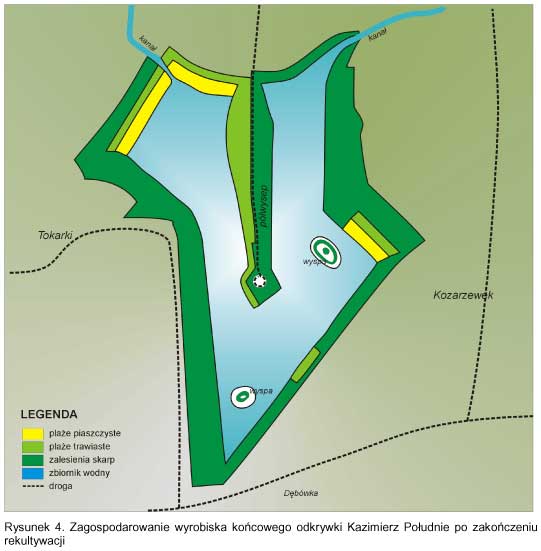
In accordance with the agreement the mine concluded with the administrative district of Kleczew, the mine carries out the technical reclamation of these elements of the "Malta BIS" recreational complex, while the local authorities will carry out a detailed plan of development for the whole area. The intention is to open the developed complex not only to the inhabitants of the nearby villages but also to visitors from other regions.
The recreational-sport complex include: a ski slope, a motocross, a golf course, a water body and an amphitheatre (fig. 5)
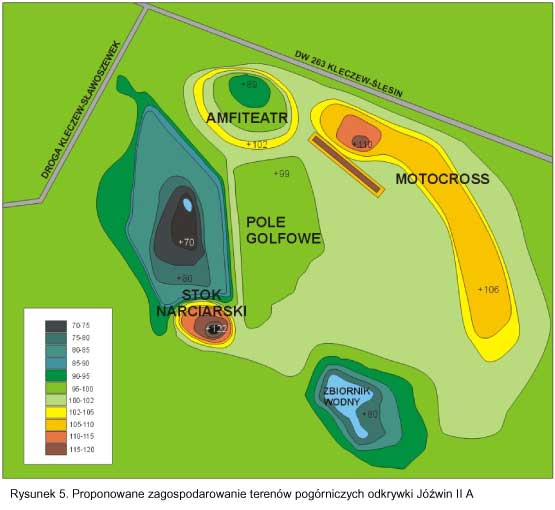
Another type of reclamation consists in providing the local authorities or other institutions that would be interested, such as The Pątnów-Adamów-Konin Power Plants, with a basin that could be used as a dumping site for various purposes or with a waste dumping site together with a proper layer of clays as a perfect insulating material. The development of such dumping sites is the responsibility of a particular administrative district or another institution.
At present, the "Konin" mine has started to carry out two largest projects concerning the development of post-exploitation drifts belonging to the "Lubstów" and Kazimierz Północ" opencast mines. The projects have been agreed upon by the local authorities. In the case of the first water body, water surface shall be approximately 475 ha in area, while when the body is filled with water its volume shall be 144 million m3. In the case of another one, the calculated water surface will be approximately 455 ha while the body will be about 97 million m3 in volume.
End drifts of existing opencast mines are developed as water bodies, which together with the nearby areas become in the future recreational-sport centres, developed in detail by an administrative district. Such developments give the regions they are located in a chance to increase their tourist attractiveness.
*
As can be seen from the above-mentioned facts, which indicate only some selected problems concerning the processes of the elimination of opencast mining drifts, mines, which operate on the basis of legal regulations, are obliged to adjust their activity to the changing legal conditions as well as growing social expectations. Attention to this sphere can be clearly seen in the mines, where the "green" activity related to the reclamation of post-mining areas and economic results are treated with equal care. This helps to increase confidence towards the mines, and at the same time improves their image in the local communities. Table 2 presents a summary of activities that the mines carry out in the field of land management.
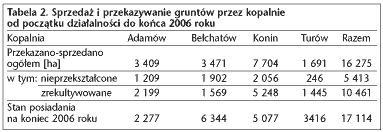
Since their beginnings, Polish brown coal mines have purchased about 33,000 ha of land, 16,000 ha of which has been given or sold so far, including 10,400 ha of reclaimed land. Taking as the criterion the amount of reclaimed land, the "Konin" mine appears to be the leader, having conducted 50 per cent of reclamation work in the whole branch. The "Adamów" mine is also in the leading position. The reason for this situation lies in the fact that these mines are typical multi-pit ones, and they exploit small brown coal deposits. In such mines new opencast mines which are being opened "help" in the reclamation of post-exploitation drifts of "old" opencast mines; this is done by situating the overburden masses or water from initial-stage drifts in the drifts of the opencast mines which are being closed.
Reclamation works conducted in our mines are rated very high by both Polish and foreign experts. Polish reclamation can be an example and a model to follow for other European countries that are involved in the opencast exploitation of deposits.
Stanisław Żuk, M.Sc.
dr Zbigniew Kasztelewicz
www.ppwb.org.pl
|

